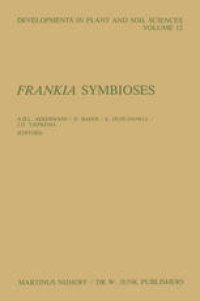
Ebook: Frankia Symbioses
- Tags: Plant Sciences, Forestry
- Series: Developments in Plant and Soil Sciences 12
- Year: 1984
- Publisher: Springer
- Edition: 1st
- Language: English
- pdf
Five years have now passed since the first symposium on frankiae was held at Harvard Forest, Petersham, Massachusetts, USA and the inauguration of the term actinorhiza. Many advances have been made during these five years in our understanding of the actinorhizal symbioses. Evidence for this was provided by the papers presented at the Wageningen Workshop on Frankia symbioses, held in Wageningen at the Department of Microbiology of the Agricultural University. Most of these papers are now published in this volume of PLANT AND SOIL. We kindly acknowledge the assistance of Anton Houwers, editor of the journal, in planning, reviewing and publishing these studies. Although the papers presented at Wageningen described the active research areas, they also illuminated those aspects of these symbioses which remain beyond our understanding. Primary among the areas of our ignorance is the concept of species within the bacterial symbiont, Frankia. At present groupings of bacterial strains are based on cell chemistry, physiology, serology, DNA homology and symbiotic capa bilities (cross-inoculation). When these classification schemes are merged no clear species framework is obtained. Undoubtedly part of the difficulty is due to a lack of strains for analysis. Currently bacterial strains from only half of the actinorhizal symbioses known to exist, have been isolated and studied in pure culture. We must postpone there fore any comprehensive taxonomic classification until a larger majority of the symbioses are represented. Another research area wherein our understanding is insufficient is host-symbiont interaction.
Content:
Front Matter....Pages I-X
Physiology and chemical diversity of Frankia spp. isolated from nodules of Comptonia peregrina (L.) Coult. and Ceanothus americanus L.....Pages 1-6
A modified sucrose fractionation procedure for the isolation of frankiae from actinorhizal root nodules and soil samples....Pages 7-13
Heterogeneity within Frankia sp. LDAgpl studied among clones and reisolates....Pages 15-22
Growth kinetics and nitrogenase induction in Frankia sp. HFPArI 3 grown in batch culture....Pages 23-28
A comparison of cultural characteristics and infectivity of Frankia isolates from root nodules of Casuarina species....Pages 29-43
Influence de basses temperatures sur la croissance et la survie de souches pures de Frankia isolees de nodules d’Aulnes....Pages 45-59
Identification of the endophypte of Dryas and Rubus (Rosaceae)....Pages 61-78
Physiological studies on N2-fixing root nodules of Datisca cannabina L. and Alnus nitida Endl. from Himalaya region in Pakistan....Pages 79-90
Growth, nitrogen fixation and relative efficiency of nitrogenase in Alnus incana grown in different cultivation systems....Pages 91-97
Selection and micropropagation of nodulating and non-nodulating clones of Alnus crispa (Ait.) Pursh....Pages 99-104
Mycorrhizal improvement in non-leguminous nitrogen fixing associations with particular reference to Hippophae rhamnoides L.....Pages 105-128
Seasonal fluctuations of the mineral concentration of alder (Alnus glutinosa (L.) Gaertn.) from the field....Pages 129-146
Growth, nitrogen accumulation, and symbiotic dinitrogen fixation in pure and mixed plantings of hybrid poplar and black alder....Pages 147-158
N2 fixation by red alder (Alnus rubra) and scotch broom (Cytisus scoparius) planted under precommercially thinned Douglas-fir (Pseudotsuga menziesii)....Pages 159-170
Alder—Frankia interaction and alder—poplar association for biomass production....Pages 171-179
Production, decomposition, and nitrogen dynamics of Myrica gale litter....Pages 181-188
....Pages 189-199